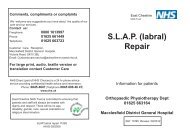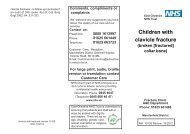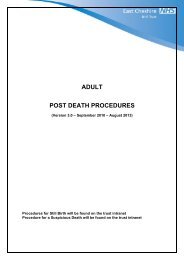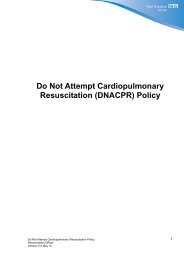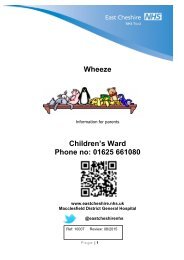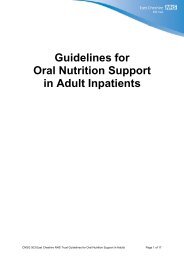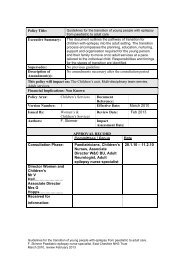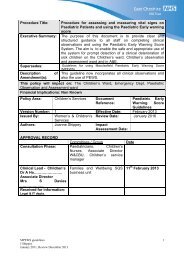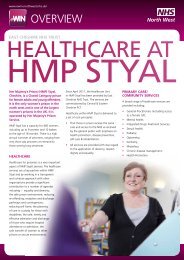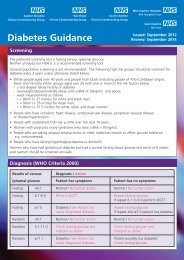Annual report 2010/11 - East Cheshire NHS Trust
Annual report 2010/11 - East Cheshire NHS Trust
Annual report 2010/11 - East Cheshire NHS Trust
Create successful ePaper yourself
Turn your PDF publications into a flip-book with our unique Google optimized e-Paper software.
Emergency preparednessPatient safety and governance‘‘ ,,I could not ask for better, all staff treated my childand myself with respect and concern. I believe theydo an excellent job that is much needed.PAEDIATRIC DIABETESRisk management34The trust has continued to demonstrate, throughoperational activity and audits, that it is well placed to dealwith a variety of emergencies. During <strong>2010</strong>/<strong>11</strong> <strong>East</strong> <strong>Cheshire</strong><strong>NHS</strong> <strong>Trust</strong> has led on and participated in numerousresilience activities, these have included:• Undertaking leadership in emergencies training formembers of the Executive Director Team.• Participating in two internal exercises and one externalmulti-agency exercise.• Implemented robust escalation plans to enable theexpansion of the Intensive Care Unit (ICU) to counter thedemand of seasonal Influenza whilst dealing with adversewinter weather conditions.• Practical training and testing of our Chemical, Biological,Radiological and Nuclear (CBRN) response capabilities.The trust has also scored 86% and 92% on external auditsfor emergency preparedness and business continuity,respectively. This has ensured that we fulfil our legalrequirements under the Civil Contingencies Act and moreimportantly ensures that <strong>East</strong> <strong>Cheshire</strong> <strong>NHS</strong> <strong>Trust</strong> meets itsvision to be the “hospital of choice”.The trust commitment to patient safety and ensuring arobust governance framework is in place and monitoringcontinued through <strong>2010</strong>/<strong>11</strong>. During the year furtherdevelopments were made in relation to the review andmonitoring of NICE (National Institute for ClinicalExcellence) guidance and National Confidential Enquiry<strong>report</strong>s to ensure ongoing learning and development isimplemented to provide safe care.The trust has also dedicated time to improving adultprotection and now works more closely and collaborativelywith Social Services to ensure concerns which are raised aredealt with quickly and effectively to support patientsand staff.During <strong>2010</strong>/<strong>11</strong> the trust remained below the nationalbenchmark of 100 for Hospital Standardised Mortality Ratio(provided by Dr Foster Intelligence) and has participated ina national mortality study known as: Preventable Incidents,Survival and Mortality Study (PRISM). The results for thestudy are due to be published to participating trusts inJune 20<strong>11</strong>.A figure of 100 means results are directly in line withexpectations. A higher figure means a higher mortality rateat the hospital. A lower figure means a low mortality rate.The safety of patients continues to be a high priority for thetrust. The trust works to achieve this by having a strong riskmanagement culture and structure in place to identify andreduce risks and therefore harm to our patients.The trusts risk management processes are supported by anannual Risk Management Strategy, which once again wasratified by the <strong>Trust</strong> Board in March <strong>2010</strong> for the year<strong>2010</strong>/<strong>11</strong>. This continues to demonstrate the board’scommitment to providing care in a safe environment.Through a process of continued review and development ofour risk management structure a reorganisation of thetrusts corporate and business unit risk registers has beencompleted. A standardised format has been implemented toensure the seamless escalation of risks up to the corporaterisk register and Board Assurance Framework. This meansthat the Executive Directors and the <strong>Trust</strong> Board are fullyaware of all significant risks to patients and theorganisation and the actions being taken to reduce orresolve these. This process also allows lessons to be learntacross all areas of the trust therefore improving patientsafety on a broader scale.35





